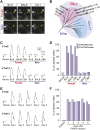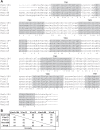Integrated action of pheromone signals in promoting courtship behavior in male mice
- PMID: 25073926
- PMCID: PMC4107909
- DOI: 10.7554/eLife.03025
Integrated action of pheromone signals in promoting courtship behavior in male mice
Abstract
The mammalian vomeronasal organ encodes pheromone information about gender, reproductive status, genetic background and individual differences. It remains unknown how pheromone information interacts to trigger innate behaviors. In this study, we identify vomeronasal receptors responsible for detecting female pheromones. A sub-group of V1re clade members recognizes gender-identifying cues in female urine. Multiple members of the V1rj clade are cognate receptors for urinary estrus signals, as well as for sulfated estrogen (SE) compounds. In both cases, the same cue activates multiple homologous receptors, suggesting redundancy in encoding female pheromone cues. Neither gender-specific cues nor SEs alone are sufficient to promote courtship behavior in male mice, whereas robust courtship behavior can be induced when the two cues are applied together. Thus, integrated action of different female cues is required in pheromone-triggered mating behavior. These results suggest a gating mechanism in the vomeronasal circuit in promoting specific innate behavior.DOI: http://dx.doi.org/10.7554/eLife.03025.001.
Keywords: GCaMP; imaging; innate behavior; olfactory; pheromone; vomeronasal.
Copyright © 2014, Haga-Yamanaka et al.
Conflict of interest statement
The authors declare that no competing interests exist.
Figures



















Similar articles
-
Impaired pheromone detection and abnormal sexual behavior in female mice deficient for ancV1R.Curr Biol. 2025 Jan 6;35(1):21-35.e8. doi: 10.1016/j.cub.2024.10.077. Epub 2024 Nov 21. Curr Biol. 2025. PMID: 39577426
-
Male pheromone protein components activate female vomeronasal neurons in the salamander Plethodon shermani.BMC Neurosci. 2006 Mar 22;7:26. doi: 10.1186/1471-2202-7-26. BMC Neurosci. 2006. PMID: 16553953 Free PMC article.
-
Encoding gender and individual information in the mouse vomeronasal organ.Science. 2008 Apr 25;320(5875):535-8. doi: 10.1126/science.1154476. Science. 2008. PMID: 18436787 Free PMC article.
-
Pheromone reception in mammals.Rev Physiol Biochem Pharmacol. 2005;154:1-35. doi: 10.1007/s10254-004-0038-0. Rev Physiol Biochem Pharmacol. 2005. PMID: 15800771 Review.
-
Refining the dual olfactory hypothesis: pheromone reward and odour experience.Behav Brain Res. 2009 Jun 25;200(2):277-86. doi: 10.1016/j.bbr.2008.10.002. Epub 2008 Oct 11. Behav Brain Res. 2009. PMID: 18977394 Review.
Cited by
-
Extracellular pH regulates excitability of vomeronasal sensory neurons.J Neurosci. 2015 Mar 4;35(9):4025-39. doi: 10.1523/JNEUROSCI.2593-14.2015. J Neurosci. 2015. PMID: 25740530 Free PMC article.
-
Experience-Dependent Plasticity Drives Individual Differences in Pheromone-Sensing Neurons.Neuron. 2016 Aug 17;91(4):878-892. doi: 10.1016/j.neuron.2016.07.034. Neuron. 2016. PMID: 27537487 Free PMC article.
-
Limbic Neurons Shape Sex Recognition and Social Behavior in Sexually Naive Males.Cell. 2019 Feb 21;176(5):1190-1205.e20. doi: 10.1016/j.cell.2018.12.041. Epub 2019 Jan 31. Cell. 2019. PMID: 30712868 Free PMC article.
-
Excreted Steroids in Vertebrate Social Communication.J Neurosci. 2018 Apr 4;38(14):3377-3387. doi: 10.1523/JNEUROSCI.2488-17.2018. Epub 2018 Mar 8. J Neurosci. 2018. PMID: 29519850 Free PMC article. Review.
-
Molecular, cellular, and developmental organization of the mouse vomeronasal organ at single cell resolution.Elife. 2024 Dec 10;13:RP97356. doi: 10.7554/eLife.97356. Elife. 2024. PMID: 39656606 Free PMC article.
References
-
- Brechbuhl J, Moine F, Klaey M, Nenniger-Tosato M, Hurni N, Sporkert F, Giroud C, Broillet MC. 2013. Mouse alarm pheromone shares structural similarity with predator scents. Proceedings of the National Academy of Sciences of the United States of America 110:4762–4767. doi: 10.1073/pnas.1214249110 - DOI - PMC - PubMed
Publication types
MeSH terms
Substances
Grants and funding
LinkOut - more resources
Full Text Sources
Other Literature Sources
Molecular Biology Databases

